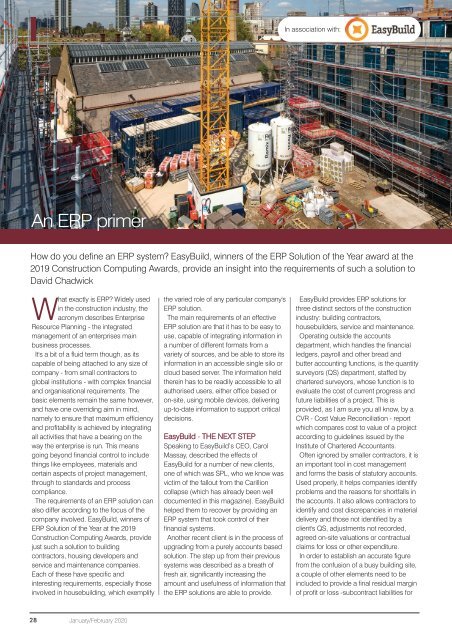CU Jan-Feb 2020
Create successful ePaper yourself
Turn your PDF publications into a flip-book with our unique Google optimized e-Paper software.
CASEstudy<br />
In association with:<br />
An ERP primer<br />
How do you define an ERP system? EasyBuild, winners of the ERP Solution of the Year award at the<br />
2019 Construction Computing Awards, provide an insight into the requirements of such a solution to<br />
David Chadwick<br />
What exactly is ERP? Widely used<br />
in the construction industry, the<br />
acronym describes Enterprise<br />
Resource Planning - the integrated<br />
management of an enterprises main<br />
business processes.<br />
It's a bit of a fluid term though, as its<br />
capable of being attached to any size of<br />
company - from small contractors to<br />
global institutions - with complex financial<br />
and organisational requirements. The<br />
basic elements remain the same however,<br />
and have one overriding aim in mind,<br />
namely to ensure that maximum efficiency<br />
and profitability is achieved by integrating<br />
all activities that have a bearing on the<br />
way the enterprise is run. This means<br />
going beyond financial control to include<br />
things like employees, materials and<br />
certain aspects of project management,<br />
through to standards and process<br />
compliance.<br />
The requirements of an ERP solution can<br />
also differ according to the focus of the<br />
company involved. EasyBuild, winners of<br />
ERP Solution of the Year at the 2019<br />
Construction Computing Awards, provide<br />
just such a solution to building<br />
contractors, housing developers and<br />
service and maintenance companies.<br />
Each of these have specific and<br />
interesting requirements, especially those<br />
involved in housebuilding, which exemplify<br />
the varied role of any particular company's<br />
ERP solution.<br />
The main requirements of an effective<br />
ERP solution are that it has to be easy to<br />
use, capable of integrating information in<br />
a number of different formats from a<br />
variety of sources, and be able to store its<br />
information in an accessible single silo or<br />
cloud based server. The information held<br />
therein has to be readily accessible to all<br />
authorised users, either office based or<br />
on-site, using mobile devices, delivering<br />
up-to-date information to support critical<br />
decisions.<br />
EasyBuild - THE NEXT STEP<br />
Speaking to EasyBuild’s CEO, Carol<br />
Massay, described the effects of<br />
EasyBuild for a number of new clients,<br />
one of which was SPL, who we know was<br />
victim of the fallout from the Carillion<br />
collapse (which has already been well<br />
documented in this magazine). EasyBuild<br />
helped them to recover by providing an<br />
ERP system that took control of their<br />
financial systems.<br />
Another recent client is in the process of<br />
upgrading from a purely accounts based<br />
solution. The step up from their previous<br />
systems was described as a breath of<br />
fresh air, significantly increasing the<br />
amount and usefulness of information that<br />
the ERP solutions are able to provide.<br />
EasyBuild provides ERP solutions for<br />
three distinct sectors of the construction<br />
industry: building contractors,<br />
housebuilders, service and maintenance.<br />
Operating outside the accounts<br />
department, which handles the financial<br />
ledgers, payroll and other bread and<br />
butter accounting functions, is the quantity<br />
surveyors (QS) department, staffed by<br />
chartered surveyors, whose function is to<br />
evaluate the cost of current progress and<br />
future liabilities of a project. This is<br />
provided, as I am sure you all know, by a<br />
CVR - Cost Value Reconciliation - report<br />
which compares cost to value of a project<br />
according to guidelines issued by the<br />
Institute of Chartered Accountants.<br />
Often ignored by smaller contractors, it is<br />
an important tool in cost management<br />
and forms the basis of statutory accounts.<br />
Used properly, it helps companies identify<br />
problems and the reasons for shortfalls in<br />
the accounts. It also allows contractors to<br />
identify and cost discrepancies in material<br />
delivery and those not identified by a<br />
client's QS, adjustments not recorded,<br />
agreed on-site valuations or contractual<br />
claims for loss or other expenditure.<br />
In order to establish an accurate figure<br />
from the confusion of a busy building site,<br />
a couple of other elements need to be<br />
included to provide a final residual margin<br />
of profit or loss -subcontract liabilities for<br />
28<br />
<strong>Jan</strong>uary/<strong>Feb</strong>ruary <strong>2020</strong>

















